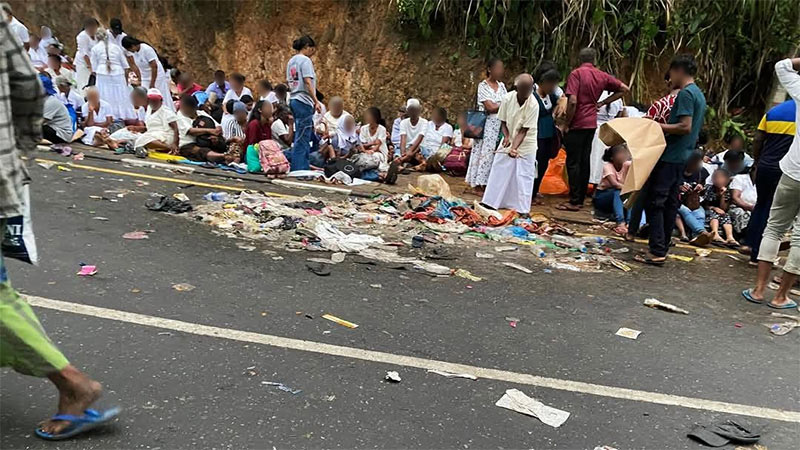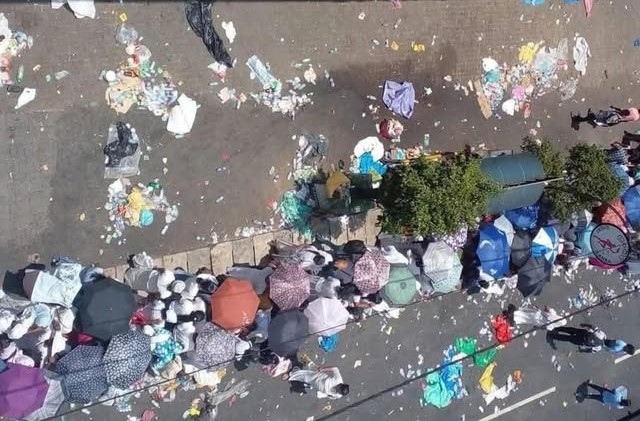By Sanuj Hathurusinghe.
With no offence to the Sacred Exposition of the Tooth Relic of Lord Buddha– ‘Siri Dalada Wandanawa’ – there is every reason for us to ponder on the events that have led to grave concern. At first, the Exposition was perceived to be a well-thought-out endeavour with thousands of Police officers deployed to ensure security and order as well as sufficient facilities, such as food, water, sanitary facilities and parking, provided for the devotees but due to the overwhelming turnout of people in Kandy, it took only a few days for the event to go out of order and for chaos to occur. The Police had to instruct the devotees to refrain from travelling to Kandy since the venue was already well over its capacity and the hundreds of thousands of public waiting in lines had already caused some grave social, environmental and sanitary issues.

Pictures of Kandy and its suburbs during the Exposition weren’t as picturesque as how Kandy usually is. Food wrappers, plastic bottles, polythene, food residue, and other waste were thrown willy-nilly onto the streets and the devotees were seen nonchalantly waiting in queues side by side, oblivious of the garbage right next to them. A few social media posts by residents and witnesses had alleged that excreta collected in polythene bags and plastic bottles had also been thrown away by the devotees, making the duties of garbage collectors extra challenging.

Whose Fault?
The extent of pollution caused by a large gathering, religious or otherwise, is largely proportionate to the number of people flocking to the venue. Since the Exposition saw hundreds of thousands of people congregating in the narrow streets of Kandy, pollution was bound to reach high levels. Understandably, the residents were voicing their concerns and pointing fingers towards the devotees blaming them for the pollution caused.
The devotees in turn claimed the facilities provided for them weren’t enough in the least and blamed authorities for the facilities provided or the lack thereof. Authorities were trying to spin the blame on the public who hadn’t heeded the guidelines and instruction updates provided by them.
On paper, the readiness for the Exposition, at first, seemed immaculate. Transportation for the devotees to Kandy was provided, sanitation and drinking water facilities were arranged in multiple locations, multiple dansalas were organised to provide food for free, several parking areas had been allocated in and around the Maligawa, accommodation for the elderly had been provided, health officials were also stationed to tend to the needs of pilgrims and even a live-updating special website was launched specifically for the Exposition, allowing the public access vital information real-time. However, it seems as if what caused all to go haywire was mainly the overwhelming turnout of people which simply was too much for Kandy to handle.
Speaking of the number of people Kandy could handle, the hill country capital is already finding it difficult to handle its own residents, in terms of providing them with sufficient sanitary facilities, wastewater disposal and drinking water supply. If anything, the Exposition and the sanitation issues that arose with, it could exacerbate the situation in Kandy which could lead to some severe long-term health and sanitary issues.
Bigger Problems
Even without the one-off events such as the Exposition, Kandy usually draws huge crowds. On a daily basis, around 375,000 visitors arrive in Kandy for tourism, administrative needs, schooling, work, medical requirements and so on. Catering to these large numbers, especially their sanitary needs, has always been a challenge for the city. Apart from a few popular shopping malls and some Municipal Council-run facilities in the city limits, there aren’t many options for tourists to fulfil their toiletry needs in the city of Kandy. On top of that, the city limits house around 125,000 tax-paying residents and business owners; fulfilling their water and sanitation needs is also burdened on the Kandy Municipal Council. Beautiful as it may seem to the unsuspecting eye, the unique topography of Kandy has made fulfilling these needs extra difficult for the authorities.
In the outskirts of Kandy city, such as Mahayyawa exist congregated communities consisting of often ‘marginalised’ workers such as garbage collectors, sweepers, and parking ticket collectors. The sanitation needs of these communities are largely unfulfilled due to the lack of proper wastewater management and sewage systems. During a field visit last year Ceylon Today found out that in Mahayyawa many households were without private toilets and depended on public restrooms and showers. In order to find sustainable solutions for the wastewater management and sanitation issues of the highly-populated areas in Kandy such as Mahayyawa, the Kandy City Wastewater Management Project – funded by Japan International Cooperation Agency (JICA) – was launched in 2010. Accordingly, it was planned that the residents should be given public/private toilet facilities and the wastewater should be collected and transported to Getambe where a Wastewater Treatment Plant was established. The plan was to treat the wastewater to reduce its toxicity to optimal levels before releasing it to the Mahaweli River.
Soon after the Project was launched, some public toilets and washrooms were established in the community and ground was broken to build collection gullies and pipelines connecting private toilet sewage pipes to the main pipeline which was supposed to bring the wastewater towards the treatment facility. However, as residents of Mahayyawa claimed, many sewage lines were yet to be connected to the treatment facility which had left them wondering where their wastewater ends up eventually.
The Project was supposed to be completed years back but when the country restructured its debt due to the economic crisis, the last segment of the JICA fund – Rs 1 billion – was not released and as a result, the Project came to a standstill. As of now, around 4.000 private households and commercial properties are properly connected to the wastewater management system while 6,000 are awaiting connection. As a result, the frequent downpour in Kandy carries around 7,000 cubic metres of untreated wastewater towards the Mahaweli River, daily.
Despite being a popular tourist hotspot, Kandy still lacks a proper and secular wastewater management system and sudden tourist attractions such as the Exposition would only worsen the situation which already is bad. Although the voices are raised for the lack of sanitary facilities for the devotees during the Exposition, the reality is that Kandy has yet to secure safe sanitary solutions for its own residents. Speaking to Ceylon Today during our last field visit to Kandy, Kandy Municipal Council’s Chief Medical Officer (CMO)
Dr. Pasan Parakum Jayasinghe opined the sustainable solution is not as easy or simple as one might think. According to him, habitats such as Mahayyawa are complex and contain a lot of illegal and ill-advised constructions and not many households are built according to the lowest required facilities. Since the area holds more population than it can sustain, the sheer population is enough to overwhelm the Project.
He also added that the limited resources and staff are also an obstacle in finding sustainable solutions. Staffed with only five Public Health Officers (PHIs) at the time, Dr. Jayasinghe revealed that one PHI was burdened with providing services to as many as 10,000 people which is double the usual capacity of an officer. Moreover, since the Project encompasses the involvement of multiple government agencies, the decision-making process tends to be a time-consuming affair and the usual lack of inter-agency communication in the government sector is also proving to be a formidable obstacle.
Although the JICA officials are hopeful that the talks with the government will soon be fruitful, a definite time frame for the Project to resume can still not be pinpointed, given the usual bureaucratic lethargy in the country. The government agencies involved in the project have tried to push the government to allocate some funds from the central government budget, instead of waiting for the last segment of funds from Japan to arrive, but their efforts haven’t so far been fruitful.
Air Pollution
On top of the existing sanitation issues in Kandy, the city is also battling with high rates of air pollution, owing to its unique geography. Located in a valley surrounded by a few key mountain ranges, Kandy experiences higher concentrations of air pollutants due to the mountains restricting the natural dispersion of pollutants, trapping them over the city.
A 2021 Research, conducted by the Department of Geology, Faculty of Science, University of Peradeniya, and published in the ‘Ceylon Journal of Science’, concluded that the pollution levels in the city are comparably high, although industrial and transportation activities in Kandy are remarkably low when compared to those in other major cities in Sri Lanka and megacities around the world. It further revealed the urgency of implementing appropriate, long-term strategies for construction and transportation activities to reduce the vulnerability of the current pollution condition of the city.
Another research conducted by the Environmental Division of the National Building Research Organisation revealed that the air quality of Kandy city is three times more polluted than that of Colombo city, owing mainly to the smoke released by the vehicles. Due to traffic congestion, a lot of vehicles travel within a small area at a very low speed. The study results also indicate relatively high pollutant levels in the Good Shed area where the main bus stand and railway station are located. Moreover, areas closer to main roads were found to be subjected to higher levels of air pollution, proving that the main air pollution source in Kandy is vehicular emissions.
Studies and hospital records have also revealed a direct correlation between the increase in the number of heart patients with respiratory disease – affecting both young and old – and the severe air pollution accumulating in Kandy city. The presence of Chronic Obstructive Pulmonary Disease (COPD) in children is also in alarming trend observed in Kandy which could be linked to its air pollution, according to studies.
‘Siri Dalada Wandanawa’ brought devotees in millions to Kandy. To facilitate the travel, special buses and trains have been scheduled and the numbers of private vehicles arriving in Kandy in the last few days were undoubtedly much higher than usual. Since the air pollution in Kandy and the vehicle emissions bear a direct correlation, it is safe to say that the Exposition aggravated not only the already existing sanitary issues in Kandy but also the air pollution the city is notorious for.
Hidden behind the veil of beauty, spirituality and history of Kandy lies a grave social and environmental issue concerning the city’s wastewater disposal mechanism and air quality. Annual events in Kandy, such as the Esala Perahera and one-off events such as the ‘Siri Dalada Wandanawa’ may spark many debates involving the attitudes and the discipline of devotees and the competency of authorities to handle large gatherings. The pragmatists and the spiritualists are already engaged in a tug of war trying to place pollution and devotion, one above the other but as the data and history suggest, the sanitary and environmental issues Kandy is facing are not just a result of one-off large gatherings but something which has been brewing within the city for decades without a sustainable solution. Since Kandy is a city that depends heavily on tourism, these underlying sanitary issues should be resolved sooner rather than later. Although it is disheartening to see the plastic and polythene pollution in the streets of Kandy, the discourse brought forward by the Exposition could shed some light on the lingering sanitary issues of Kandy and hopefully, open the eyes of authorities to spring into action.
(Pix courtesy social media)
